
The Main–Weser Railway is a railway line in central Germany that runs from Frankfurt am Main via Gießen to Kassel. it is named after the railway company that built the line and also operated it until 1880. It was opened between 1849 and 1852 and was one of the first railways in Germany.
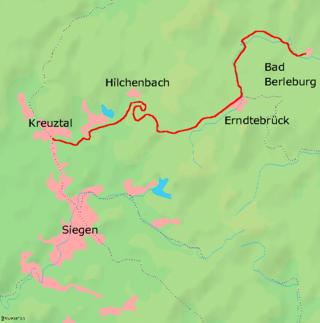
The Erndtebrück–Bad Berleburg railway is a 20 km long branch line that branches off the Kreuztal–Cölbe railway from Erndtebrück to Bad Berleburg. In Bad Berleburg there used to be a connection to the now largely dismantled Bad Berleburg–Allendorf railway to Frankenberg. The single-track, non-electrified railway line is operated as a single block branch line.

Treysa station is a train station in Schwalmstadt, Hesse, on the Main–Weser Railway. It was formerly a railway junction, connecting to the Leinefelde–Treysa section of the Cannons Railway.
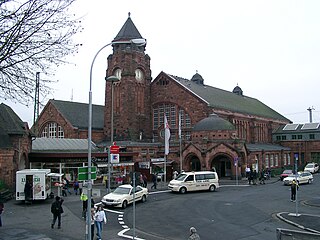
Gießen railway station is the main railway station in Gießen, Hesse, Germany. The station is a Category 2 station is used by 20,000 passengers daily. The station was opened on 25 August 1850 and is located on the Main-Weser Railway and Dill railway. The current station reception building was built between 1904 and 1911. The main original station building is a historic landmark and has been protected. Outside the station is a bus station and a taxi rank. Parking garages are located nearby.

The Sieg Railway (German: Siegstrecke is a 100-kilometre long, electrified German main line railway between Cologne-Deutz via Porz, Troisdorf, Siegburg, Hennef, Au, Betzdorf to Siegen with a through service to Cologne Hauptbahnhof. Although most of it is two-track, two five-kilometre sections are only single track. Both ends of the line are in the state of North Rhine-Westphalia, but between Au and Niederschelden it runs through Rhineland-Palatinate. It is one of the oldest lines in Germany, opened between 1859 and 1862 by the Cologne-Minden Railway Company.

Dutenhofen station is a junction station in Dutenhofen, the eastmost borough of the city of Wetzlar in the German state of Hesse. It is classified by Deutsche Bahn (DB) as a category 6 station. It is much less important than Wetzlar station and is located in the north of the suburb of Dutenhofen, near the B 49. The station is located next to a level crossing over the road to Dutenhofener See. East of the station is a junction where the Dill line to Gießen separates from the freight line that bypasses Gießen, running to the junction at Bergwald on the Main-Weser Railway. Since 1962, signalling at the station has been controlled by a small relay interlocking, which is housed in the front of the entrance building.
Mücke (Hess) station is a Keilbahnhof and, along with Nieder Ohmen station, is one of two remaining stations in the municipality of Mücke, Hesse, Germany. It is located between the two Mücke districts of Flensungen and Merlau, 28.9 kilometres from Gießen on the Vogelsberg Railway (Vogelsbergbahn), which continues to Fulda. Previously, the Friedberg–Mücke railway branched off here via Laubach and Hungen to Friedberg.

Eschhofen station lies on the Lahn Valley Railway in the town of Limburg an der Lahn in the German state of Hesse. In addition, just east of the station, the Main-Lahn Railway (Main-Lahn-Bahn) branches off to Frankfurt. The station was opened in 1863. It is classified by Deutsche Bahn as a category 5 station.
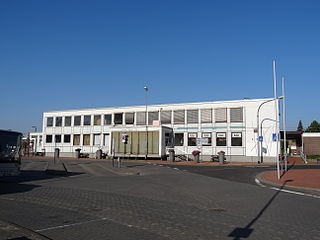
Butzbach station is a station in the town of Butzbach in the German state of Hesse on the Main–Weser Railway. The station was formerly the starting point of the Butzbach–Lich railway leading to Lich and Grünberg.The station is classified by Deutsche Bahn as a category 4 station.
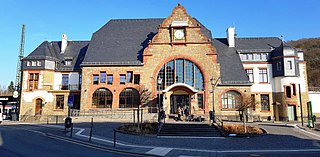
Herborn station is a railway station in the town of Herborn in the German state of Hesse on the Dill Railway. The station is classified by Deutsche Bahn (DB) as a category 4 station.

The Main-Sieg-Express is a Regional-Express service operated by the German states of North Rhine-Westphalia (NRW) and Hesse from Siegen via Gießen to Frankfurt. It is operated by the Hessische Landesbahn.

Stadtallendorf station is a through station at the 82.1 km mark of the Main-Weser Railway in the town of Stadtallendorf in the German state of Hesse. The station is classified by Deutsche Bahn (DB) as a category 4 station. The platforms, underpass and the area around the station were modernised and redecorated in preparation for the Hessentag celebrations of 2010.
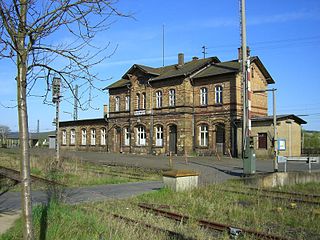
Niederwalgern station is a station on the Main-Weser Railway in the town of Niederwalgern in the German state of Hesse, south of Marburg. It is the only station of the town and the largest in the municipality of Weimar (Lahn). The station is classified by Deutsche Bahn (DB) as a category 5 station. The station is heritage-listed under the Hessian Heritage Act.

Kirchhain station is a through station at the 89.2 km mark on the Main-Weser Railway. It is located very centrally in the centre of the town of Kirchhain in the German state of Hesse. Formerly, the station was the starting point of the Ohm Valley Railway to Burg- und Nieder-Gemünden and the Wohra Valley Railway (Wohratalbahn) to Gemünden (Wohra). The station is classified by Deutsche Bahn (DB) as a category 4 station.

Nidda station is a station on the Gießen–Gelnhausen railway in the town of Nidda in the German state of Hesse. It is also at the end of the Beienheim–Schotten railway from Friedberg station. The station is classified by Deutsche Bahn (DB) as a category 4 station.

Glauburg-Stockheim station is a station on the Gießen–Gelnhausen railway in the town of Glauburg in the German state of Hesse. It is also at the end of the Nidda Valley Railway from Bad Vilbel. The Oberwald Railway (Oberwaldbahn) to Lauterbach began here from 1 October 1888 until 1 June 1984. The station is classified by Deutsche Bahn (DB) as a category 5 station.

Bad Vilbel station is located at the 183.6 kilometre mark of the Main-Weser Railway in the town of Bad Vilbel in the German state of Hesse. The Nidder Valley Railway branches from Bad Vilbel via Nidderau to Glauburg-Stockheim. It is classified by Deutsche Bahn as a category 3 station.
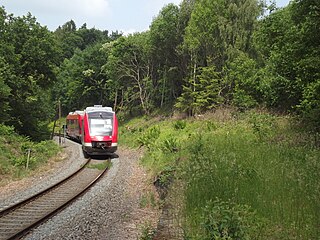
The Lahn-Eifel-Bahn is a rail passenger service in the German states of Rhineland-Palatinate and Hesse that runs as the RB 23 from Limburg an der Lahn via Koblenz and Andernach to Mayen, as RE 25 from Gießen via Limburg to Koblenz and as RB 38 from Andernach via Mayen to Kaisersesch.

Leun/Braunfels is a heritage-listed station in the district of Lahnbahnhof in the town of Leun in the German state of Hesse. It is in the network of the Rhein-Main-Verkehrsverbund (RMV) and is located on the Lahn Valley Railway (Lahntalbahn). Directly next to the entrance building was the Braunfels terminus of the Ernst Railway (Ernstbahn) to Philippstein of which only a few remains are visible. It operated from 1875 to 1962.

Albshausen is a station in the north of the district of Albshausen in the town of Solms in the German state of Hesse. The station is located on the Lahn Valley Railway (Lahntalbahn) and only a few metres from the Lahn river. Previously, the Solmsbach Valley Railway (Solmsbachtalbahn) branched off to Gravenwiesbach.




















